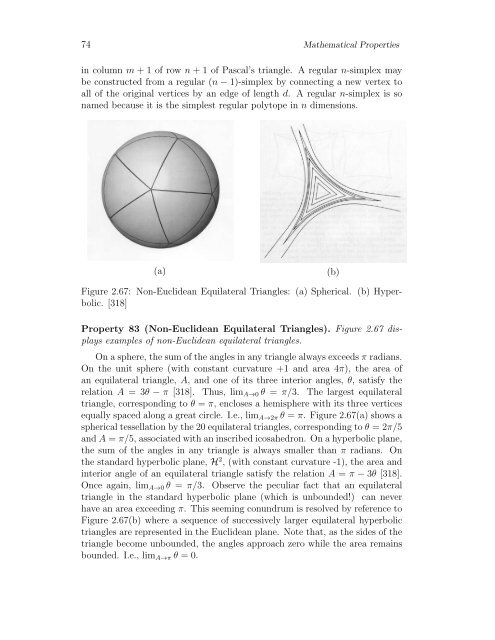MYSTERIES OF THE EQUILATERAL TRIANGLE - HIKARI Ltd
MYSTERIES OF THE EQUILATERAL TRIANGLE - HIKARI Ltd
MYSTERIES OF THE EQUILATERAL TRIANGLE - HIKARI Ltd
Create successful ePaper yourself
Turn your PDF publications into a flip-book with our unique Google optimized e-Paper software.
74 Mathematical Properties<br />
in column m + 1 of row n + 1 of Pascal’s triangle. A regular n-simplex may<br />
be constructed from a regular (n − 1)-simplex by connecting a new vertex to<br />
all of the original vertices by an edge of length d. A regular n-simplex is so<br />
named because it is the simplest regular polytope in n dimensions.<br />
(a) (b)<br />
Figure 2.67: Non-Euclidean Equilateral Triangles: (a) Spherical. (b) Hyperbolic.<br />
[318]<br />
Property 83 (Non-Euclidean Equilateral Triangles). Figure 2.67 displays<br />
examples of non-Euclidean equilateral triangles.<br />
On a sphere, the sum of the angles in any triangle always exceeds π radians.<br />
On the unit sphere (with constant curvature +1 and area 4π), the area of<br />
an equilateral triangle, A, and one of its three interior angles, θ, satisfy the<br />
relation A = 3θ − π [318]. Thus, limA→0 θ = π/3. The largest equilateral<br />
triangle, corresponding to θ = π, encloses a hemisphere with its three vertices<br />
equally spaced along a great circle. I.e., limA→2π θ = π. Figure 2.67(a) shows a<br />
spherical tessellation by the 20 equilateral triangles, corresponding to θ = 2π/5<br />
and A = π/5, associated with an inscribed icosahedron. On a hyperbolic plane,<br />
the sum of the angles in any triangle is always smaller than π radians. On<br />
the standard hyperbolic plane, H 2 , (with constant curvature -1), the area and<br />
interior angle of an equilateral triangle satisfy the relation A = π − 3θ [318].<br />
Once again, limA→0 θ = π/3. Observe the peculiar fact that an equilateral<br />
triangle in the standard hyperbolic plane (which is unbounded!) can never<br />
have an area exceeding π. This seeming conundrum is resolved by reference to<br />
Figure 2.67(b) where a sequence of successively larger equilateral hyperbolic<br />
triangles are represented in the Euclidean plane. Note that, as the sides of the<br />
triangle become unbounded, the angles approach zero while the area remains<br />
bounded. I.e., limA→π θ = 0.

















